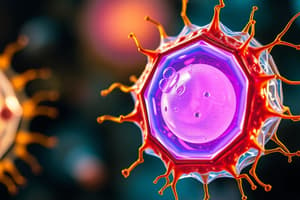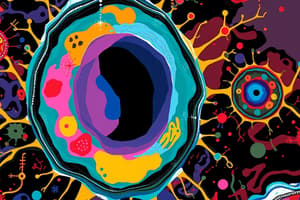Podcast
Questions and Answers
What is the main function of lysosomes in a cell?
What is the main function of lysosomes in a cell?
- Waste breakdown (correct)
- Cell division
- Protein synthesis
- Energy production
Which cellular function involves signaling between cells through chemical messengers?
Which cellular function involves signaling between cells through chemical messengers?
- Protein synthesis
- Response to stimuli
- Communication (correct)
- Transport
What is the site of photosynthesis in plant cells?
What is the site of photosynthesis in plant cells?
- Lysosomes
- Chloroplasts (correct)
- Centrosomes
- Golgi Apparatus
Which type of cells lack a membrane-bound nucleus and organelles?
Which type of cells lack a membrane-bound nucleus and organelles?
What is the primary function of the Golgi Apparatus in a cell?
What is the primary function of the Golgi Apparatus in a cell?
Study Notes
The Building Blocks of Life: Understanding Cells and Their Function
At the heart of every living organism lies a fundamental entity called the cell. Cells are the basic unit of life, responsible for performing a myriad of functions that sustain and maintain living organisms. Let's dive into the fascinating world of cells and explore their role in the intricate dance of life.
Cells: A Brief History
Cell theory, a cornerstone of biology, was established in the 19th century by Matthias Schleiden, Theodor Schwann, and Rudolf Virchow. These pioneers of cellular biology defined the cell as the basic structural and functional unit of all living organisms. Cells are often compared to bricks in a building, and organisms are like buildings themselves, made up of countless numbers of cells.
The Structural Components of a Cell
A cell can be divided into several organelles, which are specialized subunits that carry out specific functions. Some of the most important ones include:
- Nucleus: The control center of the cell, containing the genetic material in the form of DNA and RNA.
- Endoplasmic Reticulum (ER): An extensive network of membrane-bound structures responsible for protein synthesis and lipid production.
- Ribosomes: Protein-synthesizing machines composed of ribosomal RNA and proteins.
- Mitochondria: The powerhouses of the cell, generating energy through cellular respiration.
- Golgi Apparatus: Packaging center, responsible for editing and modifying proteins and lipids before they are transported to their final destinations.
- Lysosomes: Digestive organelles that break down waste and damaged cellular components.
- Centrosomes/Microtubules: Structural components involved in cell division and maintaining cell shape.
- Chloroplasts (in plants): The site of photosynthesis, converting sunlight energy into chemical energy.
Cellular Functions
Cells are responsible for numerous functions that sustain life. Some of the most important ones include:
- Protein synthesis: Transcribing and translating genetic information into proteins, which serve as structural components and catalysts for biochemical reactions.
- Metabolism: Carrying out energy-producing reactions, such as glycolysis, cellular respiration, and photosynthesis, to maintain cellular energy balance.
- Cell division: Replicating cells to grow and reproduce.
- Transport: Moving molecules, ions, and water across the cell membrane to maintain homeostasis.
- Communication: Signaling between cells through chemical messengers.
- Waste disposal: Breaking down waste products and damaged cellular components through processes like autophagy and lysosomal degradation.
- Response to stimuli: Responding to external and internal stimuli to maintain cellular function and survival.
Cells: A Diverse Array
Cells come in a variety of forms, and they can be classified under two main categories: prokaryotic and eukaryotic cells. Prokaryotic cells, such as bacteria, lack a membrane-bound nucleus and organelles. In contrast, eukaryotic cells, such as those found in plants, animals, and fungi, have a membrane-bound nucleus and organelles.
The Importance of Understanding Cells
Cellular biology is a critical field of study that has provided tremendous insights into the workings of living organisms. From understanding the molecular basis of disease to the development of novel therapeutic strategies, the study of cells has led to breakthroughs in biology, medicine, and many other fields. Thus, understanding cells and their functions is essential for anyone seeking to comprehend the complexity and beauty of life itself.
In summary, cells are the fundamental units of life, responsible for carrying out a wide range of functions that sustain and maintain living organisms. By studying cells and their components, we can gain valuable insights into the complex and intricate dance of life. History of the Cell Theory. (n.d.). Retrieved from https://www.sciencehistory.org/distillations/history-of-the-cell-theory Cell Structure and Function. (n.d.). Retrieved from https://www.ncbi.nlm.nih.gov/books/NBK557808/ Cell Function. (n.d.). Retrieved from https://www.ncbi.nlm.nih.gov/books/NBK557805/ Cell Classification. (n.d.). Retrieved from https://www.ncbi.nlm.nih.gov/books/NBK557811/
Studying That Suits You
Use AI to generate personalized quizzes and flashcards to suit your learning preferences.
Description
Delve into the fascinating world of cellular biology by understanding cells and their essential functions. Learn about the history of cell theory, the structural components of a cell, diverse cellular functions, and the importance of studying cells in various fields.





